|
|
|
|
We have been told that the rudders were turned 10°, 20° and 35° hard port 22 seconds prior the contact. Such a condition would swing out the aft end of the vessel to starboard with the ship heading up on land. The visible damages in the side are however in the port side suggesting the opposite - the rudders must have been turned 10°, 20° and 35° hard starboard prior the contact, i.e. the ship was turning away from land. Confusing, isn't it. You really wonder what happened.
On 30 March 2017 Google Earth took a photo of the ship in drydock at Genoa:
It would have been a great opportunity to study the port side hull damage in detail. But no photos exist anywhere! And a month later the complete ship had disappeared!
Why is only the vertical side above the double bottom but not the horizontal bottom of the Costa Concordia underwater hull damaged? The damage doesn't look ... real! It looks like ... ! (Yes, I know I am accused of being stupid, unscientific and unreasonable but ... I am not). The ~1.0 GJ energy worth of structural damage in the side is ~36 meter long, 3~4 meter wide and extends up to the waterline of the vessel. Ship's draught was ~8.5 meters. Was the rock outcrop, which the ship contacted, located just below the water surface? Or was the side submerged due to a sharp turn in spite of the active stabilizer fins? If the vessel had speed ~8.0 m/s before contact, it took 5 - 6 seconds or little longer. But what was speed afterwards? 4 m/s. Less? The noise during contact must have been very loud and the deceleration felt as a shock aboard, when the port aft vertical side of the ship was ripped open. On this video of an underwater obstruction with paint marks, it appears to be a vertical wall of granite ... somewhere ... deep below the water surface. Did the Costa Concordia really push hard against it? The top of the end of damage is in the vertical side just 1 meter below waterline of the ship.  Source: http://dl.dropbox.com/u/3544291/Italian%20Maritime%20MSC90%20Presentation%20Costa%20Concordia.pdf The initial inflow velocity of water at 6 meters draught is of order 10.85 m/s, thus ~10.000 tons/min inflow through an opening of 15 m², and up-flooded immediately the breached compartments and trimmed the vessel 2-3 meters on the stern and increased the ship's mean draught ~1 meter and the aft draught ~2.5 meters. The Length Between Perpendiculars, LBP, of the vessel was 247.4 m (811 ft 8 in) and, if the extent of damage (but not leakage) was 36 meters, 14.6% of LBP was affected only three watertight compartments were affected. Do ships sink, when 14.6% LBP of the side below waterline is ripped open? The structural damages involved two watertight bulkheads causing up-flooding of three watertight compartments, # 4, 5, and 6 from aft - total length about 38 meters or 15% of LBP mainly above double bottom and a loss of buoyancy of say ~9 000 m3, i.e. it was a serious incident. Only during the initial inflow of water, the loss of buoyancy is unsymmetrical and the vessel rolls slowly; first to port (if the inflow is at port). Maybe some persons fell to the decks then. After the three compartments are filled up symmetrically, vessel will upright. The affected, aft hull compartments were thus filled 100%, i.e. 10 meters depth very fast. Little time to do anything. Note that the double bottom of the ship was hardly damaged at all; only some port double bottom side compartments, i.w.o. the flooded compartments. It would appear, based on damage stability calculations done later, that Costa Concordia could in fact up-flood four watertight compartments aft (double bottom tanks mostly unaffected!) out of total 16+ watertight compartments of the whole ship and still remain floating and stable as was also observed aboard. The ship was therefore 100% safe - but abandon ship was still necessary! Schettino was quite happy. The ship could be towed for repairs. But the watertight doors must be closed! But they weren't! The situation thus was not desperate and there was time to muster all aboard and abandon the ship. According Wikipedia: "The initial impact was at a point 8 metres (26 ft) below water at the "Scola piccola" 42°21'20"N 10°55'50"E, the most seaward exposed rock of Le Scole, which tore a 50 metres (160 ft) gash in the ship's port side below the water line. The impact sheared two long strips of steel from the ship's hull; these were later found on the seabed 92 to 96 metres (302 to 315 ft) from the main island. The ship has a large boulder embedded in her hull at the aft end of the impact gash. A few minutes after the impact, the head of the engine room warned the captain that the hull had an irreparable tear of 70 metres (230 ft) through which water entered and submerged the generators and engines". Evidently the above is a typical Wikipedia falsification of the structural damages due to a contact. The gash due to contact was only 35.86 metres and at a point 0-5 metres below water. Something else happened. The ship was apparently fitted with a NAPA loading and stability computer to verify intact and damage stability. Nowadays such a computer also provides direct information of the residual/damage stability after up-flooding and it was used at the first incident to verify damage stability. All aboard knew that the ship was floating upright and stable and that nobody had died. The technical investigation should clarify this question. It was never done! Maybe the Costa Concordia loading and stability NAPA computer was not working after the black-out, i.e. not connected to the emergency electrical supply system. Ship immediately lost propulsion, normal electric power and steering and continued forward after 21.45 hrs! The emergency power and light system came into action at once! The damaged ship remained upright with no heel for at least 60 minutes. Costa Concordia neither heeled port nor starboard at this time due to the hull damages, water inflow and loss of buoyancy. Passengers and crew could easily walk on deck and in corridors to reach muster stations and lifeboats. Only later started the vessel to heel ... to starboard probably due to wind force, reduced GM (due further flooding) and ship's starboard bilge contacts forward and aft with two rocky outcrops from shore ... and capsized hours later at 00.34 hrs ... but never sank totally after capsize. The ship actually crashed against the shallow water shore area at 00.34 hrs and the deck house was locally pushed in forward and aft and then the ship was sliding down 6 meters and away 20-30 meters from shore, more at the forward end, i.e. the forward end displaced further from shore than the aft end, on the sloping sea floor damaging the starboard hull/bilge/bottom structure to finally come to rest. 32 persons drowned after 00.34 hrs. In order to capsize and sink a fourth, fifth or sixth watertight compartment must be flooded and this can only take place by progressive flooding through the 25 watertight doors that were incorrectly, illegally fitted on M/S Costa Concordia (and sister ships). It would appear this happened and should therefore be investigated. It wasn't! Ever. 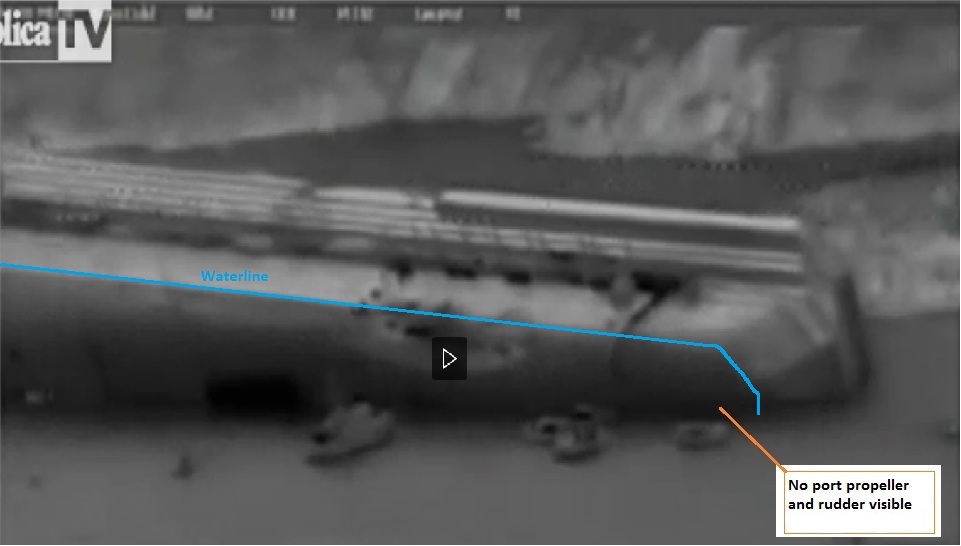 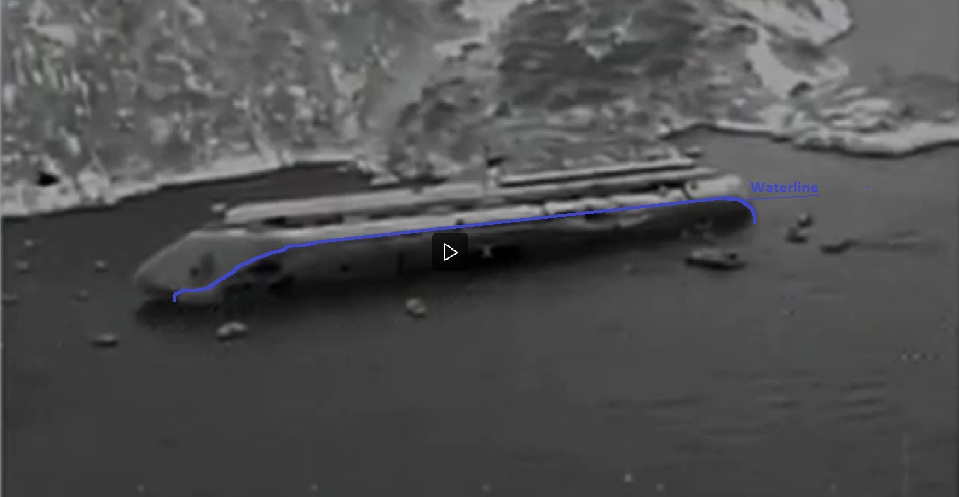 It is not clear to this observer where outside Isola del Giglio the contact in the port side occurred at 21.45 hrs. I have been there and looked around! There are apparently two small rocks right off the small Scole islet off Isola del Giglio. Which one did the vessel contact? The charts are not very clear. On this not very professional video we can see some scrap (ripped off bilge keel?) and a valve on the sea floor but the exact location is not clear. Later the divers are unprofessionally sightseeing at the ship and a propeller and rudder are seen. Who is doing this stupid underwater survey? 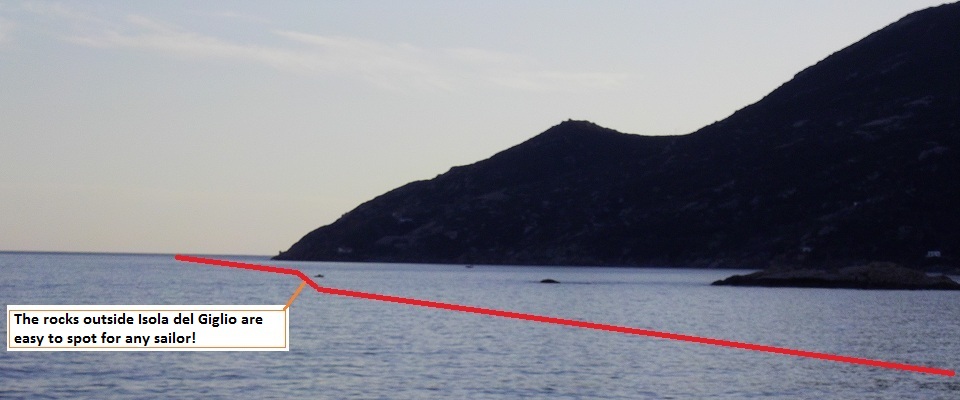 Photo - Anders Björkman Schettino was quoted by Italian news sources saying: "The area was safe, the water was deep enough. We struck a stretch of rock that was not marked on the charts. As far as I am concerned we were in perfectly navigable waters." 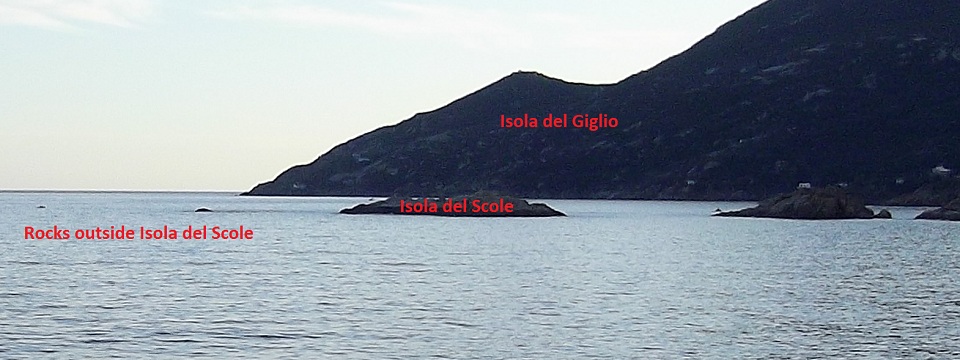 Photo - Anders Björkman Of course the area outside Isola del Scole was not safe. What charts were Schettino talking about? Sometimes I wonder how many rocks +, +, + are located outside Isola del Scole:
or:
The charts give different ideas! A look using Google map shows: 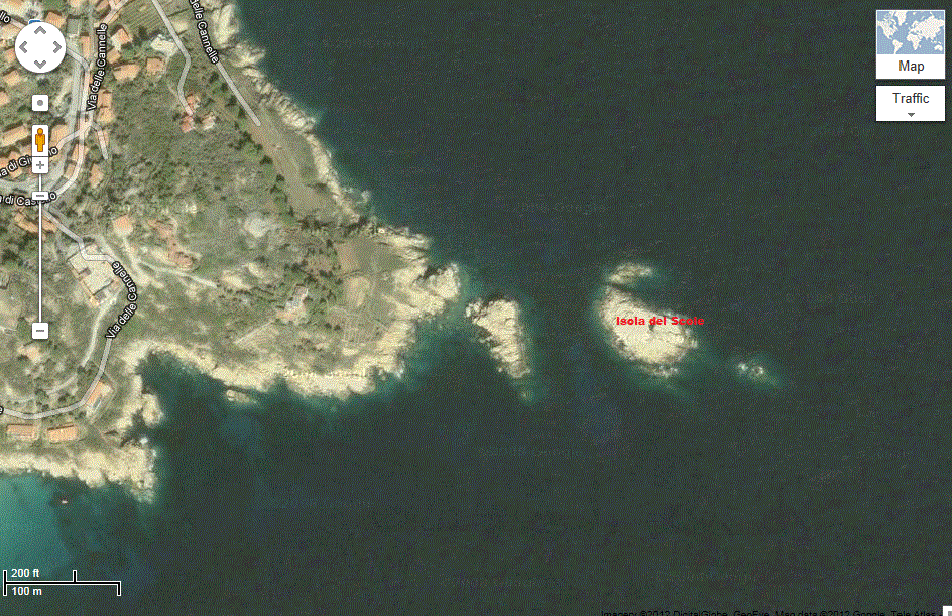 So it seems there are two (!) rocks ++ above water outside Isola del Scole. But where were they located? Here is another chart:
2019 Google Earth produces a sightly different situation outside Isola del Scole:
and the two rocks outside. Where did Costa Concordia contact anything?
Regardless. All responsible officers on Costa Concordia gathered quickly in the wheel house - the emergency center - and tried to sort out what to do! The ship was floating upright and was safe. Confusion ranged but nobody panicked. They apparently did not know which watertight compartments were flooded. At an unknown time Schettino ordered watertight doors to be closed ... but we do not know, if it were done. That watertight doors, permitted to be fitted as per SOLAS, are or should be closed at sea (from departure until arrival ports) is normally the responsibility of the chief (1st) Officer and noted in the log book. But the official, accident, judicial, insurance investigations never mention the matter. It would have been a good idea at this moment - just after the contact - to immediately order the relevant crew/staff to lower all lifeboats and hook up and inflate life rafts on the eight cranes so that abandon ship could take place later. After conferring with the DPA at Genova head quarters it was decided to raise the General Alarm and to abandon ship using the Life Saving Appliances, LSA, according to the emergency plans developed by the ship owner and the maritime authority. Now things started getting really wrong. There was not crew enough aboard to launch lifeboats and life rafts! Go to Part 3. Back to Introduction!
|